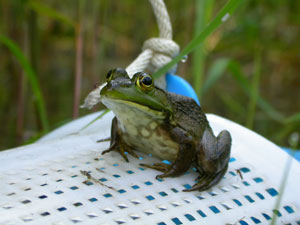Amphibian Research and Monitoring Initiative
About 270 species of frogs and salamanders comprise the amphibian fauna of the continental
U.S. Significant amphibian declines have occurred in protected areas not subjected to obvious
changes in habitat, such as national parks, wildlife refuges, and wilderness areas. Reports
of malformed frogs, toads, and salamanders are also increasing. Habitat destruction and
alteration have been shown to cause amphibian declines, but little is known about the effects
of deforestation and other habitat changes (highway construction, urban development, etc.).
Other potential stressors include: contaminants, introduced species, climate change,
ultraviolet radiation, disease, atmospheric deposition, or a variety of these factors
acting in combination. The tasks listed below are part of a collaborative, multi-agency
effort to understand the effects of environmental change upon the Nation's amphibians.
This project is managed by the Program Coordinator of the Wildlife: Terrestrial and Endangered Resources Program.
Project Tasks:
- Health and disease surveys of declining amphibian populations at regional ARMI monitoring sites.
- A cohort field study to determine the risk factors associated with the
natural transmission cycle of Ribeiroia ondatrae within snail and tadpole populations over space and time.
- Development of metabolic and phylogenic databases to survey and identify watermolds
in Amphibian egg masses as a factor in amphibian population declines.
- Emerging chytrid fungus infections in the Pacific Northwest.
- Chytrid fungus and amphibian extirpations in California and Oregon: watershed analysis of fungus and frogs.
For more information on any of the tasks listed above, please contact Gail Moede-Rogall at 608-270-2438 or via email at gamoede@usgs.gov
|

Photo by Megan Gahl
Objectives:
- Establish a network designed to monitor the status and changes in the distributions and abundance
of amphibian species and communities in the United States.
- Identify and monitor environmental conditions known to affect amphibians
and document their differences across the Nation.
- Conduct research that identifies causes of amphibian population change and malformations.
- Provide information to managers, policy makers and the general public
in support of amphibian conservation.
|
|